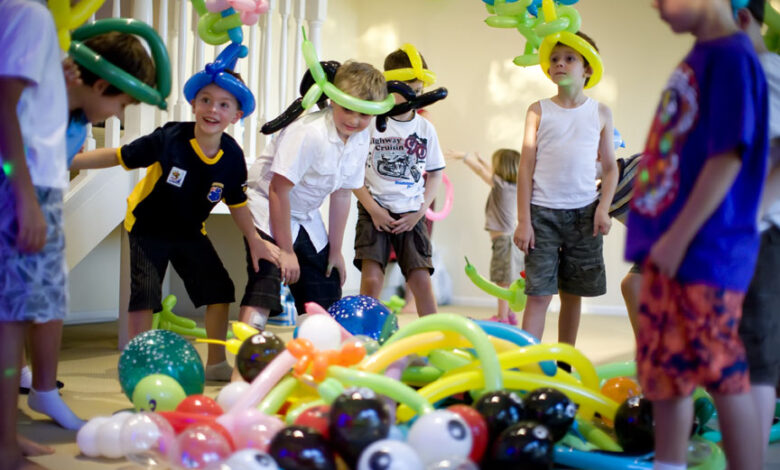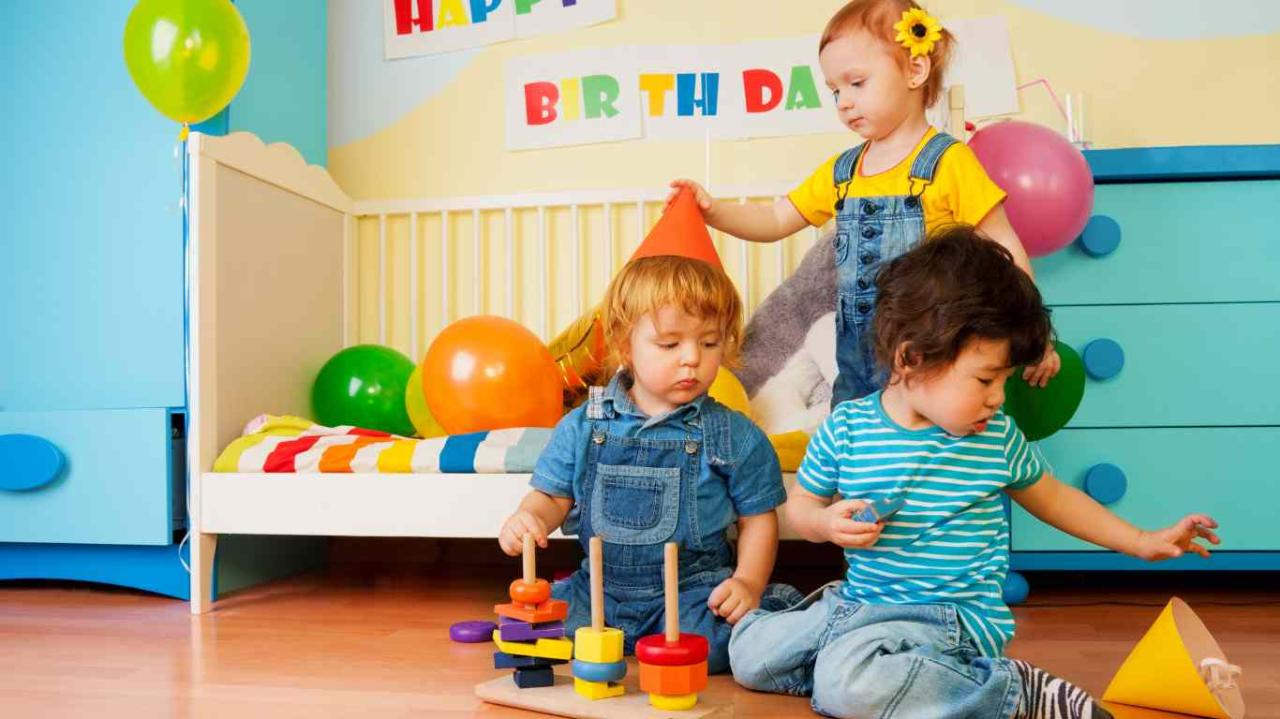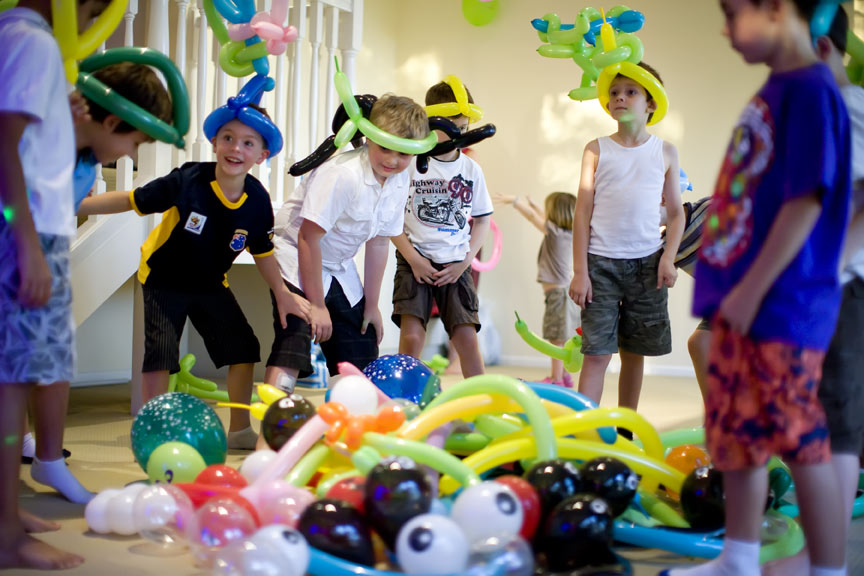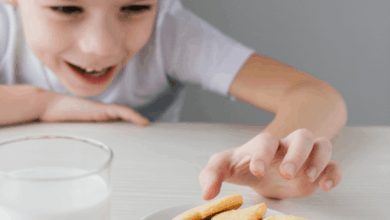
Toddler birthday party games are crucial for creating memorable and enriching experiences for young ones. This guide delves into a variety of activities, from active games that promote physical development to interactive and sensory experiences fostering cognitive growth. We’ll explore the importance of balancing active and passive play, tailoring games to different age groups and abilities, and even discussing safety precautions for a smooth and successful party.
This guide will provide a comprehensive overview of how to plan and execute a fun-filled and engaging toddler birthday party. It covers a range of games, from energetic activities to quiet, calming options, ensuring a well-rounded experience for all the little ones.
Introduction to Toddler Birthday Party Games

Toddler birthday parties are a wonderful opportunity for children to socialize, learn, and develop crucial skills. Engaging activities are paramount to a memorable and enriching experience. Choosing the right games is key to capturing their attention and fostering their growth. This focus on appropriate and stimulating activities ensures that the party is both fun and educational.Toddlers are in a critical developmental stage, learning and exploring the world around them.
Their attention spans are typically short, and they thrive on activities that are interactive, sensory-rich, and promote physical and cognitive development. Games should cater to their specific needs and encourage exploration, problem-solving, and social interaction.
Planning toddler birthday party games can be tricky, especially when juggling the many demands of modern parenting. Finding the perfect balance between fun and manageable activities is key, especially given the unique child care challenges parents face today. For example, navigating the evolving landscape of childcare options and the impact of the pandemic on family structures is a real struggle for many, as detailed in this insightful article about child care challenges how are parents managing due to the pandemic.
Luckily, there are plenty of engaging and age-appropriate options for keeping little ones entertained at a birthday bash. Simple, interactive games are often the best bet, ensuring everyone has a blast!
Active Games for Toddler Development
Active games are essential for toddlers’ physical development and gross motor skills. They allow them to burn energy, practice coordination, and build strength. These games often involve running, jumping, and movement, which are crucial for developing their bodies and balance.
- Simple Obstacle Courses: Use pillows, blankets, tunnels, and chairs to create a safe and engaging obstacle course. This encourages coordination and problem-solving as they navigate the course.
- Musical Games: Music encourages movement and rhythm. Simple songs and dances can be very engaging, promoting their coordination and following directions.
- Red Light, Green Light: A classic game that promotes quick reaction time, body control, and listening skills. This is also a fun and exciting way for the toddler to experience teamwork and interaction with other children.
Passive Games for Sensory Exploration
Passive games are equally important for stimulating toddlers’ senses and cognitive development. These games often involve exploring textures, colors, and shapes, promoting fine motor skills and visual recognition.
- Sensory Bins: Fill a large bin with rice, beans, or dried pasta and add colorful objects for exploration. This engages multiple senses and promotes tactile exploration.
- Color Sorting Games: Use various colored blocks or shapes to sort them into categories, enhancing their color recognition and cognitive skills. This can also be paired with shapes, building fine motor skills.
- Play-Doh or Clay: These materials provide opportunities for tactile exploration, creativity, and fine motor development. Letting toddlers explore the different textures and molding qualities can be a great way to engage their senses.
Age-Appropriate Games
The age range of toddlers often dictates the complexity and duration of games. It is important to tailor games to match their attention spans and developmental capabilities.
| Age Range | Game Examples |
|---|---|
| 18-24 months | Simple stacking toys, soft blocks, peek-a-boo, simple songs and dances. |
| 2-3 years | Shape sorters, puzzles with large pieces, ball games, simple obstacle courses, dress-up. |
| 3-4 years | More complex puzzles, building blocks, board games with simple rules, hide-and-seek, and simple arts and crafts. |
Parent/Guardian Involvement
Parent/guardian involvement is crucial in ensuring the success of toddler party games. Their active participation can foster a positive social environment and encourage their child’s development.
- Modeling Behaviors: Parents can model appropriate social interaction, patience, and respect.
- Leading by Example: Demonstrating the correct way to play games, encouraging teamwork, and celebrating successes.
- Encouraging Participation: Helping toddlers interact with each other and encouraging them to participate in different activities.
Active Games for Toddlers
Toddlerhood is a crucial period for physical development. Active play is essential for fostering gross motor skills, balance, coordination, and spatial awareness. Engaging in fun, age-appropriate games helps children explore their bodies, develop strength, and build confidence. This section explores various active games suitable for toddlers, highlighting their benefits and offering adaptations for diverse needs.
Active Games for Toddlers, Toddler birthday party games
Active games are not just fun; they are vital for a toddler’s physical development. Each game engages different muscle groups, promoting strength, coordination, and balance. Choosing games that cater to their individual abilities and interests is key to creating a positive and enriching experience.
- Musical Statues: This classic game improves a toddler’s ability to follow instructions, develop rhythm and timing, and enhance their body awareness. It helps build their attention span as they wait for the music to start and stop. The physical act of freezing in different poses promotes body awareness and coordination.
- Obstacle Course: Setting up a simple obstacle course using pillows, blankets, tunnels, and cushions encourages gross motor skills, balance, and problem-solving. Toddlers navigate the course, improving spatial reasoning and their ability to overcome challenges.
- Red Light, Green Light: This game is great for developing a toddler’s reaction time and following instructions. The fast-paced nature of the game helps enhance their coordination and response speed.
- Parachute Play: Using a large parachute engages toddlers in cooperative play, promoting teamwork, hand-eye coordination, and gross motor skills as they learn to move the parachute in various ways. It enhances social interaction by requiring cooperation.
- Ball Games: Simple ball games like catching, throwing, and kicking enhance hand-eye coordination, gross motor skills, and spatial awareness. The repetitive nature of these activities reinforces these skills.
Adapting Games for Diverse Needs
Toddlers have different abilities and needs. Adapting games ensures inclusivity and creates a fun experience for all. For example, if a toddler has limited mobility, the obstacle course can be simplified with fewer obstacles or using a smaller area. For toddlers with sensory sensitivities, quieter games or reduced stimulation may be beneficial. Careful observation and adjustment are key to making the games enjoyable and developmentally appropriate for every child.
Comparing Active Games
| Game Name | Benefits | Space Requirements | Difficulty Level |
|---|---|---|---|
| Musical Statues | Following instructions, rhythm & timing, body awareness | Small to medium | Easy |
| Obstacle Course | Gross motor skills, balance, problem-solving | Medium to large | Medium |
| Red Light, Green Light | Reaction time, following instructions, coordination | Medium | Easy to Medium |
| Parachute Play | Teamwork, hand-eye coordination, gross motor skills | Medium | Medium |
| Ball Games | Hand-eye coordination, gross motor skills, spatial awareness | Small to medium | Easy |
Detailed Steps for Musical Statues
| Step | Description | Visual Aid (describe, not link) |
|---|---|---|
| 1 | Start with upbeat music. Have the toddlers move freely, dance, and explore the space. | Toddlers dancing and moving around the room with music playing. |
| 2 | When the music stops, the toddlers must freeze in a pose. | Toddlers in various poses, standing still. |
| 3 | Encourage creative poses, such as standing on one foot, or mimicking an animal. | Toddler in a yoga pose, mimicking a cat. |
| 4 | Continue playing the game, gradually increasing the tempo and complexity of the poses. | Toddlers in more complex poses, such as holding a pose for longer periods, as the music plays. |
| 5 | (Variation for younger toddlers) Use simple instructions like “hands up”, “feet together”, or “touch your nose”. | Toddlers with hands raised and feet together, or touching their noses. |
| 6 | (Variation for older toddlers) Introduce more complex movements like hopping, jumping, or stretching. | Toddlers hopping, jumping, or stretching in various ways. |
Interactive & Sensory Games
Toddlerhood is a crucial period for development, and play is the cornerstone of learning. Interactive and sensory games provide a unique avenue for exploration, fostering cognitive and sensory skills while encouraging creativity and problem-solving abilities. These engaging activities not only entertain but also promote crucial developmental milestones in a fun and enriching way.Sensory experiences play a vital role in shaping a child’s understanding of the world.
By interacting with various textures, colors, and sounds, toddlers develop a deeper connection to their environment and build essential neural pathways. These games also help them learn about cause and effect, and improve their hand-eye coordination.
Interactive Sensory Exploration Activities
Interactive sensory games are crucial for stimulating a toddler’s senses and promoting cognitive growth. These activities allow them to explore the world around them through touch, sight, sound, smell, and taste (within safe limits, of course). Through exploration, toddlers learn about different textures, colors, and shapes, leading to better understanding and memory.
- Water Play: Water play is a fantastic sensory experience. Toddlers can explore different containers, pour water, and observe how water flows. This activity develops fine motor skills, hand-eye coordination, and problem-solving skills as they experiment with different vessels and try to pour water into them. The tactile experience of water, along with the various sounds it makes, enhances sensory development.
Ensure the water is shallow and the area is supervised. Using various sized containers and funnels adds complexity to the game.
- Play-Doh or Clay Exploration: Working with Play-Doh or clay encourages fine motor skills, hand-eye coordination, and creativity. Toddlers can sculpt, roll, and shape the material, developing their dexterity and imagination. The tactile experience of the different textures of Play-Doh or clay provides a sensory learning opportunity. Variations include different colors and adding small objects for enhanced play.
- Sensory Bin Adventures: Sensory bins filled with various objects like dried beans, pasta, rice, or colorful pom-poms allow toddlers to explore textures and develop their tactile senses. This activity helps with fine motor skills, hand-eye coordination, and problem-solving as they sort and explore the contents of the bin. Safe materials like dried beans or rice are crucial for this activity.
Different colors and shapes can be added to the bin to enhance the visual sensory experience.
- Musical Instruments: Introducing toddlers to musical instruments like shakers, drums, or xylophones stimulates their auditory senses and develops their sense of rhythm. This activity fosters creativity and imagination, as toddlers experiment with different sounds and rhythms. The various sounds and vibrations help in sensory development. The focus should be on the exploration of sounds, rather than on specific musical skills.
- Color Sorting Activities: Using colored blocks, shapes, or objects, toddlers can sort them based on color. This activity enhances their color recognition and categorization skills, supporting cognitive development. The visual stimulation and the need to match objects to specific criteria help in developing problem-solving skills. A variety of colored objects, including different shapes and sizes, is helpful for toddlers to engage in more complex sorting activities.
Importance of Safe Materials
Using safe and appropriate materials is paramount in sensory play. Avoid materials that could pose a choking hazard or be harmful to a toddler’s health. Always supervise toddlers during sensory play and ensure the materials are age-appropriate. Choose materials that are washable and easy to clean. For example, avoid small beads or items that could be easily swallowed.
Focus on materials that encourage exploration and discovery, while prioritizing safety.
Quiet & Calming Games
Toddler parties are a whirlwind of energy and excitement, but it’s crucial to remember that even the youngest guests need moments of calm. Quiet games are essential for maintaining focus, promoting relaxation, and preventing overstimulation. Incorporating a mix of active and quiet activities ensures that the party is enjoyable for everyone.Quiet games are important to counterbalance the high-energy activities.
Planning toddler birthday party games can be tricky, but thankfully, there are tons of fun ideas out there. Thinking about how much healthcare costs these days, though, makes me wonder how much of that goes into the overall cost of things. It’s a real eye-opener to read about the factors influencing healthcare costs in this insightful Q&A with a doctor, q a with the doctor who can tell you why healthcare costs an arm and a leg , and it’s a good reminder to focus on creating a memorable and affordable celebration for the little ones.
Luckily, simple sensory bins or a themed scavenger hunt can keep those little ones entertained and happy.
They allow toddlers to process sensory input and recharge. This helps them transition between different activities, preventing exhaustion and maintaining a positive party experience. A well-balanced program is essential to avoid overstimulation, which can lead to meltdowns and make it difficult for the children to enjoy the party.
Importance of Quiet Games
Toddlers, particularly in a party setting, can become overwhelmed by excessive stimulation. Quiet games provide a necessary break, allowing them to regain focus and calm down. These activities are vital for promoting a sense of well-being and enjoyment. They allow toddlers to develop their attention spans and self-regulation skills, which are crucial for their overall development.
Examples of Quiet Games
- Color Sorting: Provide toddlers with a variety of colored objects (e.g., blocks, buttons, or pom-poms). Explain the concept of colors and ask them to sort them based on their hues. This activity promotes color recognition and fine motor skills. It’s a good introduction to categorization and helps with focus.
- Shape Matching: Similar to color sorting, provide shapes and corresponding cut-outs for matching. This exercise improves cognitive skills by helping toddlers identify and match shapes. It’s excellent for early learning and encourages problem-solving.
- Quiet Storytelling: Read a simple story aloud. Use soft, calming music in the background to enhance the experience. Engage toddlers by asking simple questions about the story and encouraging them to participate. Storytelling fosters language development and imagination. Simple stories with repetitive phrases can be especially engaging for toddlers.
Planning toddler birthday party games can be tricky, but the key is to keep it fun and engaging for all the little ones. Sometimes, the energy and enthusiasm of a toddler party can mirror a manic episode, but it’s important to remember that those are very different things. Understanding the difference between typical toddler exuberance and conditions like mania in bipolar disorder is crucial for parents and caregivers.
If you’re curious to learn more about what is mania in bipolar, check out this informative resource: what is mania in bipolar. Ultimately, though, the focus remains on selecting age-appropriate games that encourage interaction and laughter at the party.
- Sensory Bins: Fill a container with dried beans, pasta, or rice. Provide small toys and scoops for toddlers to explore. This sensory activity promotes fine motor skills and tactile exploration. It can be calming and stimulating in a controlled way.
- Simple Puzzles: Offer age-appropriate puzzles with large pieces. Guide toddlers through the puzzle-solving process. This activity promotes problem-solving skills and hand-eye coordination. Start with very basic puzzles to maintain engagement.
Creating a Calming Atmosphere
Using storytelling and music can significantly enhance the calming atmosphere. Soft, instrumental music in the background can help set a relaxed tone. Choose music with a gentle tempo and soothing melodies to promote tranquility. A simple story, read in a calm and engaging voice, can also help reduce stress and create a sense of peace. The stories can be tailored to the themes of the party, which will help enhance the engagement.
Tailoring Games to Different Age Groups
Quiet games should be adapted to the age of the toddlers. Younger toddlers may benefit from simpler activities that focus on sensory exploration, while older toddlers might enjoy more complex tasks that challenge their cognitive abilities. For example, younger toddlers may benefit from activities involving simple colors, while older toddlers can engage with puzzles involving more complex shapes.
Careful consideration of the developmental stage is important to ensure that all toddlers have a positive and enjoyable experience. Using colorful and engaging items can also help keep toddlers interested.
Party Favors & Decorations: Toddler Birthday Party Games

Throwing a toddler birthday party is all about creating a fun and safe environment where little ones can explore, play, and make memories. A crucial part of this is selecting appropriate party favors and creating a visually appealing and engaging space. These elements contribute significantly to the overall success and enjoyment of the party for both the birthday child and all the guests.Careful consideration should be given to the design and selection of party favors that are not only fun but also safe and age-appropriate.
Matching the party favors to the overall theme adds a cohesive touch, creating a memorable experience for the attendees.
Party Favor Selection
Party favors are a fantastic way to extend the fun beyond the party’s duration. Interactive favors, like small play-doh sets, mini construction toys, or colorful sticker books, encourage continued play after the event. These items can spark creativity and imaginative play at home. Additionally, favors tied to the party’s theme, like mini cars for a race car theme or animal figurines for a jungle theme, add a special touch.
Remember, safety is paramount. Choose favors that are non-toxic, free of small parts that could be choking hazards, and appropriate for the age range of the attendees.
Interactive Party Favors
Interactive party favors encourage ongoing play, fostering creativity and imagination. Examples include small play-doh sets, mini building blocks, or coloring books with themed stickers. These items offer opportunities for children to continue engaging in activities beyond the party.
Safe & Age-Appropriate Favors
Safety is a top priority when choosing party favors. Favors should be free of small parts that could pose a choking hazard, and they should be made from non-toxic materials. Always check the labels and packaging for safety certifications and warnings before purchasing. Consider the ages of the children attending the party, ensuring that the favors are appropriate for their developmental stage and abilities.
Party Area Decoration
Decorating the party area is an essential part of creating an engaging and safe environment for toddlers. The decor should be colorful, but not overwhelming. Bright, playful colors are often appealing to young children, but avoid overly stimulating colors that might cause distraction. Ensure that all decorations are securely attached and out of reach of toddlers to prevent accidents.
Decoration Themes
The table below provides examples of different decoration themes for toddler birthday parties, including suggested colors, materials, and decorations.
| Theme | Colors | Materials | Decorations (describe, not link) |
|---|---|---|---|
| Jungle | Greens, browns, oranges | Cardboard, fabric, balloons | Jungle animals cutouts, leafy green streamers, faux plants, and vibrant orange and yellow balloons. |
| Superheroes | Blues, reds, yellows | Cardboard, fabric, balloons | Superhero-themed banners, red and blue balloons, superhero character cutouts, and colorful streamers. |
| Ocean | Blues, greens, purples | Paper, fabric, balloons | Ocean-themed banners, blue and green balloons, fish cutouts, and ocean-themed streamers. |
Safety Considerations for Toddler Parties
Planning a toddler’s birthday party is a joyous occasion, but it’s crucial to prioritize safety. Toddlers are curious and active, making them susceptible to potential hazards. Careful planning and preparation are essential to ensure a fun and safe environment for all.Creating a secure and enjoyable atmosphere for toddlers requires a proactive approach to anticipate and mitigate risks. Understanding common hazards and implementing appropriate safety measures are paramount to a successful and worry-free celebration.
Food Safety Precautions
Ensuring food safety is critical for preventing illness. Food prepared for toddlers needs special attention. Harmful bacteria can multiply quickly at room temperature, especially in warm environments.
- Keep food cold until serving time, using appropriate coolers and ice packs.
- Serve food immediately after it’s heated and avoid keeping it warm for prolonged periods.
- Thoroughly wash all fruits and vegetables before preparing them. This step is crucial to prevent the presence of harmful bacteria.
- Avoid serving raw or undercooked foods, particularly meat, poultry, or eggs. Always cook these items to the proper internal temperature to kill any potential harmful bacteria.
Choking Hazards
Toddlers have a higher risk of choking on small objects. It’s essential to be vigilant about potential choking hazards.
- Prepare food in manageable sizes, avoiding hard or small pieces that could be easily swallowed.
- Cut food into small, bite-sized pieces, ensuring they are not too small or hard for toddlers to chew safely. For example, avoid grapes, nuts, hard candies, and chunks of raw vegetables.
- Supervise children closely while they are eating, to ensure they are not placing foreign objects in their mouths.
- Never leave a child unattended while they are eating.
- Avoid giving small toys, beads, or other small objects that could be choking hazards.
Play Area Safety
Creating a safe play area is essential for a toddler’s party. Toddlers are active and inquisitive, which makes them prone to injuries if the play area is not properly secured.
- Clear the play area of any tripping hazards, such as loose wires, cords, or scattered toys.
- Ensure that the play area is free of any sharp objects or furniture that could injure a toddler.
- Use appropriate safety barriers, like baby gates or playpen enclosures, to define the play area and prevent toddlers from wandering into dangerous areas.
- Place soft, padded mats or carpets on the floor to cushion falls.
- Inspect and maintain all toys, ensuring that they are in good working order and free of any loose parts that could pose a choking or injury risk.
Adult Supervision
Constant adult supervision is paramount for toddler safety.
- Never leave a toddler unattended, even for a moment.
- Maintain close observation of all children at all times, ensuring they are safe and engaged in age-appropriate activities.
- Ensure that adults are aware of the location of first aid supplies and emergency contacts in case of an accident.
- Designate a specific adult to oversee the safety of the toddlers at all times.
Safety Checklist
This checklist will help in preparing a safe environment for toddlers.
- Check for tripping hazards and remove them.
- Ensure that all food is prepared safely, following guidelines to prevent illness.
- Cut food into appropriate sizes to prevent choking.
- Supervise children constantly.
- Maintain a safe play area with soft surfaces.
- Have first-aid supplies and emergency contacts readily available.
Conclusive Thoughts
In conclusion, planning a toddler birthday party requires careful consideration of various factors. From selecting age-appropriate games to ensuring a safe environment, this guide provides a roadmap for creating a fun and memorable experience. Remember, the goal is to provide engaging activities that encourage learning, growth, and joy for the little ones. Happy planning!





